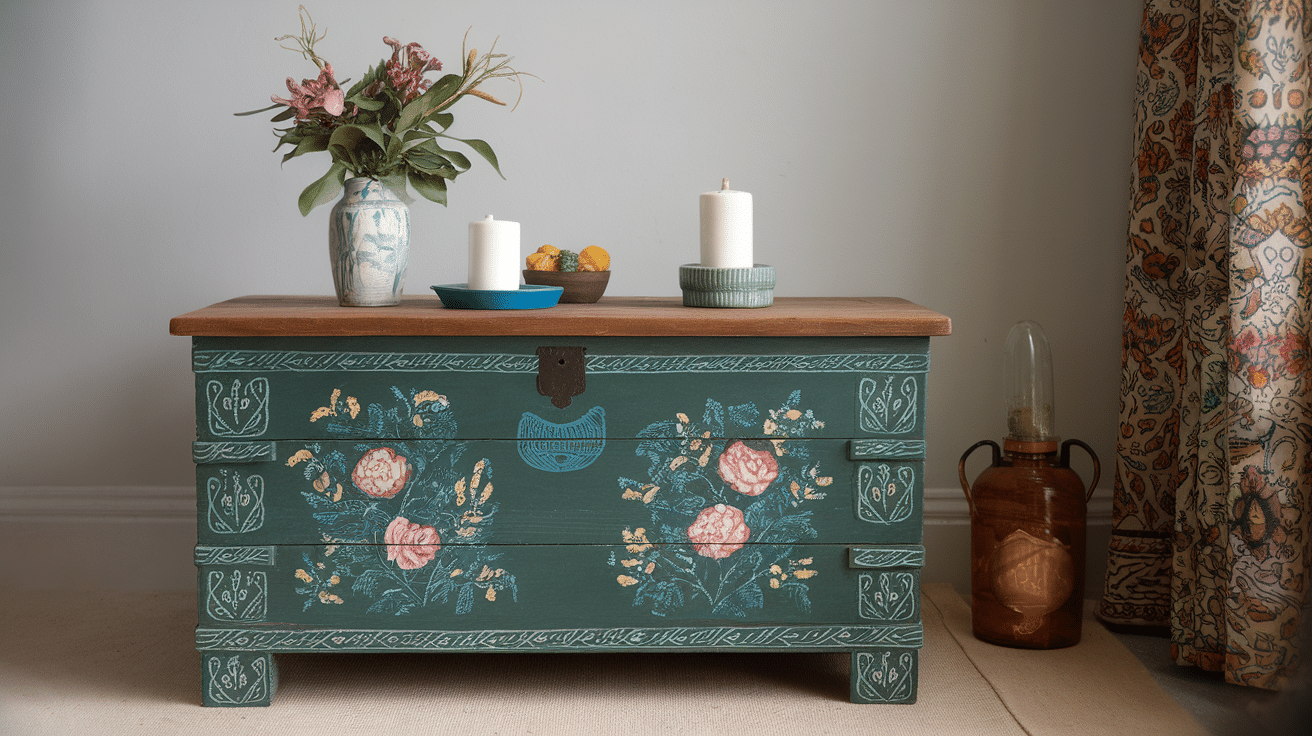Hidden beneath layers of dusty varnish and outdated finishes lies sleeping potential. That cedar chest tucked away in your attic or inherited from Grandma isn’t just a relic—it’s your next statement piece waiting to happen!
Imagine turning that forgotten wooden vault into a conversation starter that preserves heirlooms and upgrades your decor. No specialized woodworking skills are required—just creativity, patience, and this guide.
Ready to rescue your chest from design obscurity? Follow these steps to metamorphose practical storage into an art piece that honors its heritage while turning heads. The cedar’s protective properties remain intact while its exterior gets the makeover it deserves.
The Secret Life of Cedar Chests
What makes these pieces truly special isn’t just their history—it’s their remarkable duality. While you sleep, these guardians work silently, their aromatic wood repelling moths and preserving textiles without harsh chemicals.
The very same cedar oils that protect your treasured fabrics create that nostalgic scent that triggers memories every time you lift the lid.
Unlike mass-produced storage solutions, these chests age gracefully, developing character with each passing year.
By modernizing only the exterior, you’re participating in a beautiful paradox: preserving tradition through modification. This restoration isn’t just about the artistic—it’s about honoring craftsmanship while breathing contemporary relevance into functional art.
Step-by-Step Guide to Paint Cedar Chest
Tools and Materials Needed
| Item | Use |
|---|---|
| White Lightning cleaner | Clean surface |
| Bonding Boss primer (gray) | Primer coat |
| Foam roller & brushes | Paint application |
| Dixie Bell Mud | Fill holes |
| Manatee Gray Chalk Paint | Main color |
| Espresso Gel Stain | Stain finish |
| Stain applicator pads | Apply stain |
| Wedding Lace transfer | Decoration |
| Gator Hide/Satin Clear Coat | Seal finish |
| Blue sponge | Apply sealer |
| Disposable gloves | Hand protection |
| Screwdriver | Remove hardware |
| Clean rags | Wipe surface |
| Spray bottle with water | Blend/activate designs |
Step 1: Assess and Prepare Your Cedar Chest
Begin by thoroughly examining your cedar chest, noting any damage, dated hardware, or areas needing special attention.
Remove all hardware using a screwdriver and store it safely—especially the original lock mechanism, which should be placed in a bag inside the chest (it’s illegal to sell cedar chests with the original lock intact).
Clean the entire piece thoroughly using White Lightning cleaner to remove dirt, oils, and residue. This deep cleaning ensures proper primer and paint adhesion, creating a strong foundation for your project.
Step 2: Apply Bonding Boss Primer
Apply a coat of Bonding Boss primer in gray using a foam roller for flat surfaces and disposable brushes for recessed areas. This specialized primer serves multiple purposes: it provides adhesion without sanding, blocks tannins that might bleed through your paint, and creates an even base color.
Cover the entire piece evenly, ensuring all surfaces are properly primed. Allow the primer to dry completely for a full 24 hours before moving to the painting stage—this waiting period is crucial for proper adhesion.
Step 3: Fill Hardware Holes
While waiting for the primer to dry, fill any unwanted hardware holes with Dixie Bell’s Mud. Apply the filler slightly above the surface level, allowing for shrinkage as it dries.
Once dry, lightly sand the filled areas flush with the surrounding surface to create a seamless finish.
This step gives you flexibility with your design choices—you can either add new hardware later or leave the piece hardware-free for a cleaner look. For this project, the decision was made to eliminate hardware to showcase the decorative transfer.
Step 4: Paint the Base of the Chest
Apply two even coats of Dixie Bell Manatee Gray chalk mineral paint to the entire base of the cedar chest. This neutral gray tone provides a perfect backdrop for the decorative transfer while updating the look of the piece.
Allow each coat to dry thoroughly before applying the next. To open the bottom drawer that previously had hardware, pull from the scalloped edge at the bottom. The neutral color choice ensures that this piece will work with various decor styles.
Step 5: Refinish the Top with Gel Stain
While the paint on the base dries, refinish the top of the chest. Apply Espresso Gel Stain to the wooden top using applicator pads and wearing gloves to protect your hands.
Work in the direction of the wood grain, starting with the lip of the chest that remains visible when closed.
Apply the stain generously, then use overlapping strokes to smooth it out. This rich, dark brown stain covers the dated red finish without requiring sanding to bare wood. Allow the stain to dry completely according to the manufacturer’s instructions.
Step 6: Seal the Stained Top
Once the gel stain is completely dry, seal the top with Gator Hide protective topcoat using a slightly dampened blue application sponge. The light moisture in the sponge helps distribute the sealer evenly.
Apply in the direction of the wood grain with overlapping strokes to prevent streaking. This durable topcoat protects the stained surface from water rings, scratches, and daily wear. To ensure maximum durability, allow the sealer to cure completely before using the piece.
Step 7: Apply Decorative Transfer
Prepare your decorative transfer by planning its placement on the chest’s inset panels. For this project, the Wedding Lace transfer was positioned across the front panels, excluding the middle shell design area.
Carefully peel the backing from the transfer, exposing the sticky side, and position it precisely on your painted surface.
Using the enclosed burnishing tool, firmly rub over the entire transfer to adhere the design to your furniture. You’ll notice a slight color change in the transfer as it releases from the carrier sheet.
Step 8: Seal the Entire Piece
After the transfer is completely adhered, protect your work by sealing the entire painted base of the chest with Satin Clear Coat. This protective layer prevents the transfer from being damaged by fingerprints and daily use while also protecting your paint finish.
Apply the sealer evenly using a clean, slightly damp blue sponge in smooth, overlapping strokes.
Allow the sealer to dry completely before moving or using the furniture to ensure maximum protection and durability for your newly transformed cedar chest.
Video Tutorial
Check out this YouTube video for a detailed step-by-step Tutorial by The Top Drawer Rva.
Keep Your Painted Cedar Chest Looking Its Best
Keep your chest looking fresh and lasting longer with simple maintenance.
Regular Dusting and Cleaning
Dust your painted cedar chest regularly using a soft, lint-free cloth to prevent buildup. When deeper cleaning is needed, use a slightly damp cloth with mild soap, avoiding harsh chemicals that can damage the protective topcoat.
Always dry the surface immediately after cleaning to prevent moisture damage. For stubborn spots, try a small amount of white vinegar diluted with water rather than commercial cleaners.
Protecting the Finish
Preserve your cedar chest’s finish by using coasters under drinks and felt pads under decorative objects. Avoid placing the piece in direct sunlight, which can cause the paint color and transfer design to fade.
When moving items on top of the chest, lift them rather than slide them to prevent scratches. These simple protective measures will significantly extend the beauty of your furniture piece.
Preserving Cedar Properties
Maintain the internal cedar properties by lightly sanding the interior with fine-grit sandpaper once a year to rejuvenate the natural cedar aroma.
Avoid using cleaners inside the chest that might mask the cedar scent or interfere with its moth-repellent properties. Allow the chest to air out periodically, especially in humid climates, to prevent mustiness from developing inside.
Things to Avoid
| Action to Avoid | Potential Consequence | Better Alternative |
|---|---|---|
| Using original locks | Illegal to sell; safety hazard | Store lock inside chest or replace |
| Skipping primer | Tannin bleed-through | Use tannin-blocking primer |
| Rushing dry time | Poor adhesion, peeling | Wait a full 24 hours between steps |
| Using water-based products on a fresh stain | Damage to finish | Allow oil-based stain to dry completely |
| Heavy use before curing | Fingerprints and damage | Allow 3-4 weeks for complete curing |
| Direct sunlight exposure | Fading | Position away from UV exposure |
Conclusion
As your brush makes its final stroke and the sealer dries to a perfect sheen, step back and admire what you’ve created. This isn’t just furniture—it’s a bridge between eras, a conversation between generations.
Your converted chest now stands ready for its second act: holding new memories while honoring its past. The hands that first crafted this piece would surely smile at your thoughtful renewal, at how you’ve ensured its journey continues.
Place it proudly in your living space. Let it spark stories and questions. Watch as friends run their fingers along the decorative transfer, amazed at your craftsmanship.
This chest is now part of two stories—the one it came from and the one you’re writing. Its beauty is no longer hidden, its purpose no longer forgotten.
Welcome to the family, old friend. You look magnificent.
Frequently Asked Questions
Can Cedar Be Painted White Without Sanding?
Yes, cedar can be painted white without sanding if you use a bonding primer designed for glossy or raw wood surfaces.
Is a Cedar Chest Worth Anything?
Yes, a cedar chest can be valuable, especially if it’s vintage, handcrafted, or in good condition.
What Kind of Paint Do You Use on Cedar?
Use acrylic latex paint or chalk paint on cedar, paired with a quality primer for best results.
















